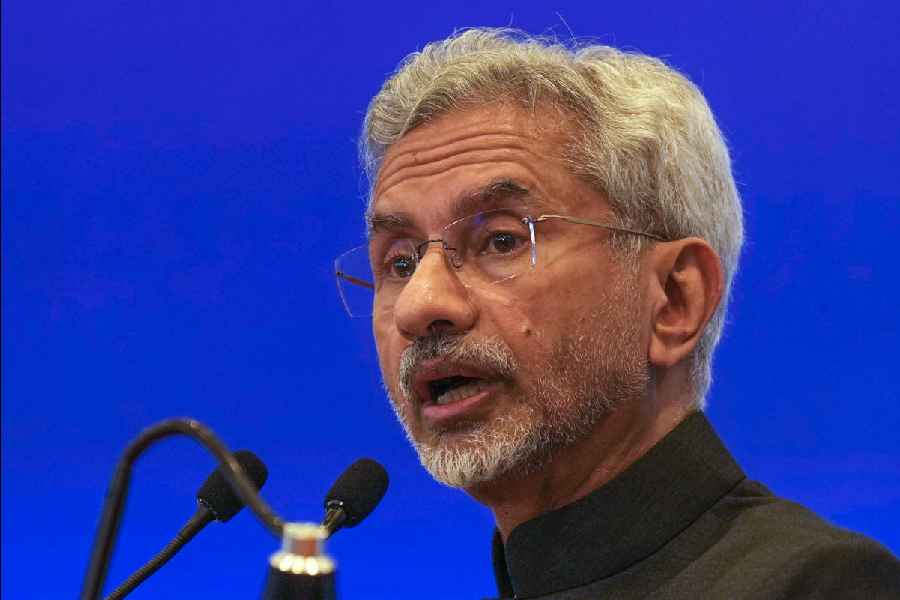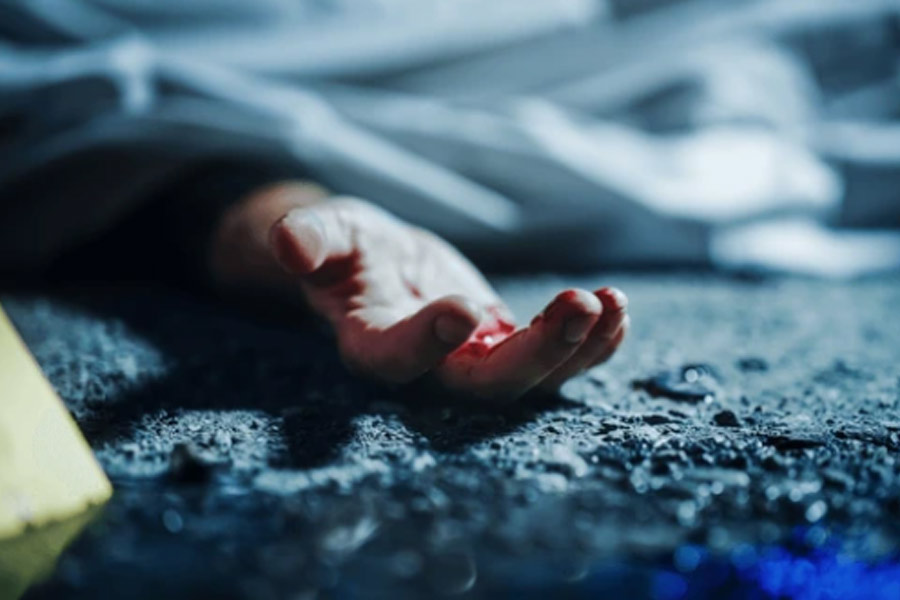
The house that once belonged to Pratapchandra Ghosh at 27 Baranasi Ghosh Street, which is of great historical and architectural significance, has been taken over by promoters.
This dilapidated building is located in Ward 25 of the Calcutta Municipal Corporation, in the Jorasanko area, where famous scholar and satirist Kaliprasanna Singha, of Hutom Penchar Naksha fame, once lived.
It is included in the CMC's list of heritage structures as a Grade I landmark singled out for its arched gateway. So it does not matter if the building is erased so long as the gate is intact.
At the head of the arched gateway used to sit a small figure of Buddha in meditation, and on the supporting columns on either side are represented the zodiac signs and the nine planets ( nabagraha). A copper plate was fixed under it. Both the Buddha figure and the copper plate disappeared after the promoters took over the property about two to three years ago. Now the front gate is always shuttered.
A notice hangs from the arched gateway: This property belongs to Shahjahan Biswas, SK Jahiruddin, Sheela Jain, Raj Kumar Agarwal.
Urban historian Debasis Bose related the history of the family and the building. Shantiram Singha of Baksha (a village adjacent to Janai) in Hooghly district amassed a huge fortune in Calcutta by serving as a banyan and dewan of Thomas Rumboldt, an officer of the East India Company.
He died an untimely death, leaving behind his two underage sons, Prankrishna and Joykrishna. He had appointed three executors of his will -Nilmani Mitra of Darjipara, after whom Nilmani Mitra Street is named, Baranasi Ghosh (after whom the street is named), Shantiram's own son-in-law, and Sitaram Ghosh of Sarsuna, who was Shantiram's brother-in-law. But Nilmani and Baranasi broke faith with him, and Sitaram Ghosh was so disgusted by their betrayal that he declined the executor's post.
When Prankrishna came of age, he got back much of his property through legal proceedings against the two double-crossers, Nilmani and Baranasi. Thereafter, the Singhas and the family of Sitaram Ghosh became attached to each other by bonds of trust.
Prankrishna Singha persuaded his cousin, Abhay Charan Ghosh, the only son of Sitaram Ghosh, to settle down opposite his house. Abhay Charan's family came to be known as the Ghoshes of Jorasanko. Abhay Charan's youngest son, Harachandra Ghosh (1808-1868), became a judge of the Small Causes Court, and his bust still stands in that building.
The relationship of mutual trust and respect continued, and when Satu Singha, who was Prankrishna's nephew and Joykrishna's son, died a premature death, he appointed Harachandra Ghosh executor of his will.
So Harachandra Ghosh became the guardian of Satu Singha's only son, Kaliprasanna Singha.
Harachandra Ghosh lived in this building. Harachandra was a pupil of David Hare and Derozio, and he began his career as a munsif, later became a junior magistrate in Calcutta, and thereafter was appointed a judge of the Small Causes Court, and remained in that post till death.
Krishnadas Pal was Harachandra Ghosh's blue-eyed boy, and it was at the latter's behest that Kaliprasanna Singha appointed Krishnadas editor of the Hindu Patriot.
Harachandra Ghosh had four sons - Pratapchandra, Saratchandra, Debendrachandra and Gyanendrachandra. He died in 1868.
Harachandra's son-in-law was Harchunder Dutt of Rambagan, and under his influence, Gyanendrachandra converted to Christianity. Gyanendrachandra's only son and daughters died young, and he bequeathed a huge endowment to the University of Calcutta - Rs 123,400 in August 1919 - in the memory of his son, Stephanos Nirmalendu Ghosh.
Harachandra Ghosh's eldest son, Pratapchandra, and Gyanendrachandra were like chalk and cheese. After graduation, Pratapchandra joined the Asiatic Society as its assistant librarian, was an active member, and an English and Sanskrit scholar. He was also registrar of deed & joint stock companies.
He wrote a novel titled Gangadhip Parajoy, on the fall of Pratapaditya, and in his youth, Rabindranath Tagore used to read it out to his sister-in-law, Kadambari Debi. Tagore was so enthused by it that he wrote Bouthakuranir Haat based on the same story.
Pratapchandra with the help of Tibetan lamas read the entire corpus of Buddhist scriptures, and discovered that the suffix Ghosh used to used by Buddhists. For example, Ashwaghosha was author of Buddhacharita. Thereafter, he declared himself a Buddhist bhikshu, and it was he who added the Buddhist elements like the arched gateway to the building.
He affixed a huge marble plaque on the northern side of the first-floor verandah, and on it was inscribed the history of the Ghosh family in Sanskrit.
Above the plaque was the head of Harachandra Ghosh in a medallion. In the courtyard was a temple-like structure. He gave the children of the next generation rather unusual names such as Shankhachura, Ajatashatru, Priyadarshan, Shudduodhan and Jayatsen.
As a Buddhist mendicant he retired to Vindyachal and died in 1921. He used to call himself Pratapachandra Ghosha, and although he was a friend of Kaliprasanna Singha's from childhood, the satirist did not spare him in his Hutom.
This architecturally and historically important house was inherited by the descendants of Saratchandra Ghosh, and it is they who have handed it over to promoters.










